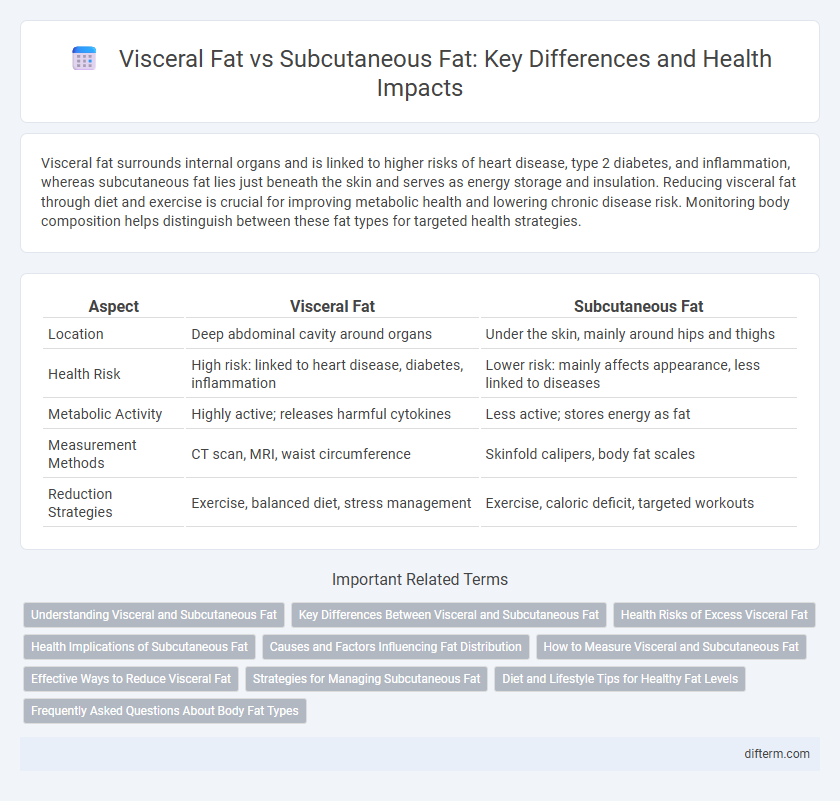Visceral fat surrounds internal organs and is linked to higher risks of heart disease, type 2 diabetes, and inflammation, whereas subcutaneous fat lies just beneath the skin and serves as energy storage and insulation. Reducing visceral fat through diet and exercise is crucial for improving metabolic health and lowering chronic disease risk. Monitoring body composition helps distinguish between these fat types for targeted health strategies.
Table of Comparison
| Aspect | Visceral Fat | Subcutaneous Fat |
|---|---|---|
| Location | Deep abdominal cavity around organs | Under the skin, mainly around hips and thighs |
| Health Risk | High risk: linked to heart disease, diabetes, inflammation | Lower risk: mainly affects appearance, less linked to diseases |
| Metabolic Activity | Highly active; releases harmful cytokines | Less active; stores energy as fat |
| Measurement Methods | CT scan, MRI, waist circumference | Skinfold calipers, body fat scales |
| Reduction Strategies | Exercise, balanced diet, stress management | Exercise, caloric deficit, targeted workouts |
Understanding Visceral and Subcutaneous Fat
Visceral fat, located deep within the abdominal cavity, surrounds vital organs and is linked to higher risks of metabolic disorders such as type 2 diabetes and cardiovascular disease. Subcutaneous fat lies beneath the skin and serves as an energy reserve and insulation, typically posing less health risk compared to visceral fat. Understanding the distinct roles and health impacts of visceral and subcutaneous fat is crucial for targeted weight management and improving overall metabolic health.
Key Differences Between Visceral and Subcutaneous Fat
Visceral fat surrounds internal organs and is linked to higher risks of cardiovascular disease, diabetes, and inflammation, while subcutaneous fat is located beneath the skin and serves primarily as energy storage and insulation. Visceral fat is metabolically active, releasing harmful cytokines and hormones that affect insulin sensitivity, whereas subcutaneous fat has a less pronounced impact on metabolic health. Measuring waist circumference or using imaging techniques like MRI provides accurate assessment of visceral fat, unlike skinfold calipers which mainly estimate subcutaneous fat levels.
Health Risks of Excess Visceral Fat
Excess visceral fat, stored deep within the abdominal cavity around vital organs, significantly increases the risk of cardiovascular diseases, type 2 diabetes, and metabolic syndrome. Unlike subcutaneous fat, which lies beneath the skin and is less harmful, visceral fat releases pro-inflammatory cytokines that contribute to insulin resistance and chronic inflammation. High levels of visceral fat are strongly linked to elevated blood pressure, abnormal cholesterol levels, and increased mortality rates from heart-related conditions.
Health Implications of Subcutaneous Fat
Subcutaneous fat, located directly under the skin, plays a crucial role in cushioning the body and regulating temperature. This type of fat acts as an energy reserve and is generally less harmful to metabolic health compared to visceral fat. Research indicates that higher levels of subcutaneous fat are associated with lower risks of cardiovascular disease and type 2 diabetes, emphasizing its protective health implications.
Causes and Factors Influencing Fat Distribution
Visceral fat accumulates around internal organs due to factors such as high sugar intake, chronic stress, and sedentary lifestyle, increasing the risk of metabolic disorders. Subcutaneous fat, located beneath the skin, is influenced by genetics, hormone levels, and overall calorie balance. Age, gender, and insulin resistance also play crucial roles in determining whether fat is stored viscerally or subcutaneously, impacting health outcomes differently.
How to Measure Visceral and Subcutaneous Fat
Visceral fat can be measured using advanced imaging techniques such as MRI or CT scans, providing accurate assessment of fat surrounding internal organs. Subcutaneous fat is commonly estimated through skinfold calipers, which measure fat thickness beneath the skin at specific body sites. Bioelectrical impedance analysis (BIA) offers a non-invasive method to estimate total body fat, but it cannot differentiate easily between visceral and subcutaneous fat layers.
Effective Ways to Reduce Visceral Fat
Reducing visceral fat requires targeted approaches including a combination of regular aerobic exercise like brisk walking or cycling, and strength training to increase muscle mass and boost metabolism. Incorporating a high-fiber, low-sugar diet rich in whole grains, vegetables, and lean proteins effectively lowers insulin resistance and inflammation linked to visceral fat. Monitoring stress levels and ensuring quality sleep also play crucial roles in hormonal balance and visceral fat reduction.
Strategies for Managing Subcutaneous Fat
Targeted strategies for managing subcutaneous fat include a combination of consistent aerobic exercise and strength training to boost metabolism and promote fat loss. Nutritional approaches emphasize a balanced diet rich in whole foods, fiber, and lean proteins while limiting processed sugars and saturated fats. Stress management and adequate sleep are also crucial for regulating hormones that influence subcutaneous fat accumulation.
Diet and Lifestyle Tips for Healthy Fat Levels
Reducing visceral fat, the harmful fat stored around internal organs, requires a diet rich in whole foods like vegetables, lean proteins, and whole grains while limiting added sugars and refined carbs. Incorporating regular aerobic exercise and strength training enhances metabolic rate and promotes fat loss, targeting visceral fat more effectively than subcutaneous fat. Adequate sleep, stress management, and avoiding excessive alcohol intake further support maintaining healthy fat levels and improving overall insulin sensitivity.
Frequently Asked Questions About Body Fat Types
Visceral fat, located deep within the abdominal cavity, surrounds vital organs and poses higher health risks such as heart disease and type 2 diabetes compared to subcutaneous fat, which lies just beneath the skin and serves as energy storage and insulation. Measuring waist circumference and body composition helps differentiate these fat types for targeted health strategies. Understanding the differences between visceral and subcutaneous fat is crucial for effective weight management and reducing metabolic disorders.
Visceral Fat vs Subcutaneous Fat Infographic

 difterm.com
difterm.com